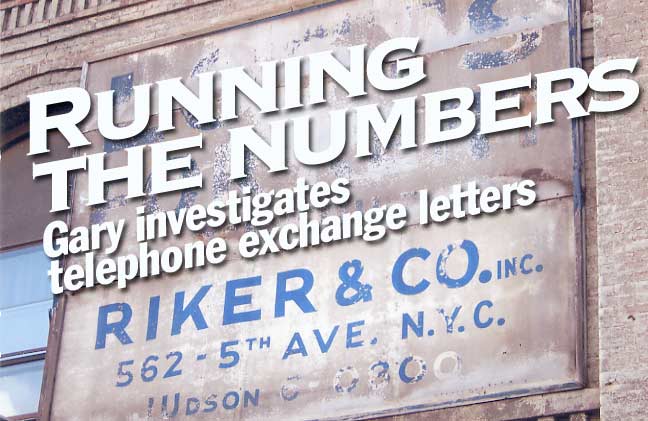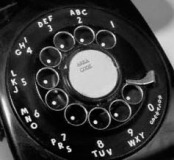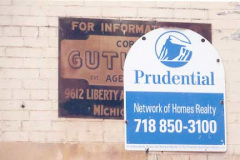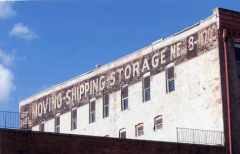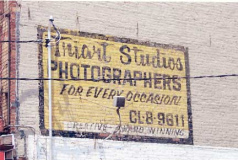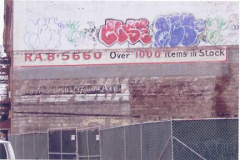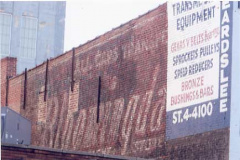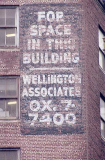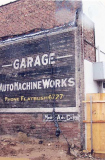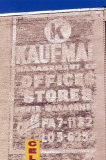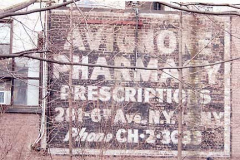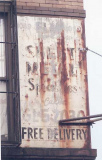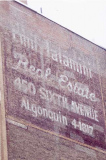By GARY FONVILLE
Forgotten NY Correspondent
Once upon a time, telephone customers were assigned alphanumeric telephone numbers. For example, the numbers were such as FOundation 8-3556 (now 368-2556), MOnument 2-2491 (now 662-2491) or NEvins 8-3886 (now 638-3886). The letters and first digit designated a certain geographic area and were referred to as exchanges. Numbers beginning with FOundation were in the vicinity of Lenox Avenue and 135th Street in Manhattan. A large segment of today’s population have no idea of the concept of alphanumeric telephone numbers. However, FNY’s busy camera has captured traces of the phone company’s past and brought them to light.
“You could learn about a fella by knowing his exchange. A MOnument fella was up near 100th Street and West End Avenue. You could picture him coming downtown on the IRT, strolling first to 96th and Broadway for the newspapers, passing the Riviera and Riverside movie theaters (both gone). The ATwater girl was an East Side girl, a taxi-hailing girl, on her way to her job at Benton and Bowles. A CIrcle fella was a midtown fella, entering his CIrcle-7 Carnegie-area office with a sandwich from the Stage Deli. And what about a SPring-7 girl, twirling the ends of her long brown hair as she lay on her bed talking to you on the phone? A Greenwich Village girl. A 777 girl is nothing. She is invisible. She is without irony, seldom listens to music.” — Jonathan Schwartz, New York Magazine, December 21 – 28, 1987, as reproduced in Once Upon a Telephone: An Illustrated Social History, (1994) Stern and Gwathmey, New York. Harcourt Brace and Company. p.47
LEFT: The complete ad for this Ozone Park, Queens business has been obscured by a more contemporary business that we are all familiar with. North side of 96th Street & Liberty Avenue.
RIGHT: NEvins 8-1200 was the number for this moving/shipping enterprise. Atlantic Avenue & Perry Place, Bedford-Stuyvesant, Brooklyn.
LEFT: The number CL8-9611 (CL for CLoverdale) connected you to Triart Studios in Flatbush, Brooklyn. East side of Flatbush Avenue near Avenue K.
RIGHT: Riker & Co. Inc on 5th Avenue could be contacted by dialing JUdson 6-0200. South side of Canal Street near Baxter Street, Chinatown, Manhattan.
LEFT: A business could advertise here by first calling ST4-5522. Grand & Thompson Streets, Manhattan. (FFans…help us out on this one: ST was either STagg or STerling.)
RIGHT: Here’s a two for one special! Dialing RAvenswood 8-5660 lets you inquire about the 1000 items in stock. 32nd Street & Astoria Boulevard. Astoria, Queens. A second faded at at the bottom is too indistinct to make out.
LEFT: MUrray-hill 3-0410, East side of Second Avenue near 37th Street.
RIGHT: Just when you think all of NYC’s old Bloomingdale’spainted ads have been located, one pops up. This correspondent saw the sign that advertised a business at ST4-4100 BEFORE seeing the Bloomie’s sign. What a find! East side of Jackson Avenue between Queens Street & Dutch Kills Street. (I’m told this was STillwell)
(Bloomingdale’s and Castoria probably have dozens of still-visible painted ads around town. It probably just comes down to the quality paint that was used.)
LEFT: How long has space been available on this Beaver Street building near William Street in the Financial District?
(OX is off my source list, but I’d bet it stood for OXford.)
RIGHT: This sign was meant to be seen by riders on the now demolished Myrtle Avenue el near Broadway. HYacinth- something.
Both these signs, featuring plenty of lettering, attest to how precise wall ads had to be laid out – a tribute to the wall dogs’ expertise.
LEFT: Picture was shot in April 2007. This one’s an oldie because there’s no single digit after the exchange name and before the actual four-digit phone number. It would be like dialing FL?-6727. Sad to say this sign will disappear again due to construction.
(Any FFans want to help us out with this dilemma?)
ForgottenFan Steven Peculic: I saw your recent page that listed phone exchanges with their letter codes. The letter code used to be three characters, not two. My grandparents had a phone with an RAV-#### number. That stood for RAVenswood. That means that the RAV area can only accomodate 9999 phones. That had to be expanded. In the early fifties they made the letter exchanges two characters and that phone defaulted to RA8. I remember people talking that the ‘real’ Woodside phones all began with RA8 and other people with, say, RA6 exchanges, were Johnny-come-latelys. BTW, that RAV phone was in Woodside on 31st Ave between 55 and 56 Street. My living great aunt has a phone that begins with 278, which stands for AST. She had that phone since 1949. It is located on 43 street between Broadway and 34 ave. The same thing happened with Astoria. All phones were AST (278). Then they became AS# (27#). That happened in the late fifties. Then phone numbers were totally randomized (early eighties).
That ad with FLAtbush-#### is at least 60 years old.
ForgottenFan John Schmidt: Your question re FLatbush 6727. This goes back to the days when phone numbers were the area (Exchange) and 4 digits (6 characters total). I have a 1948 Atlas of Nassau and Queens Counties that has ads in it for real estate companies in Suffolk. One of the numbers listed is SMithtown and 4 digits. What Ma Bell did when they went over to seven character numbers in the late 20s or early 30s was to take the number corresponding to the the third letter in the exchange. As Steven said earlier about Woodside also applied to the people in Woodhaven Queens. Those with VIrginia 7 numbers are the originals, the 846, 845 and 848s came later.
As far as the ST exchanges, STAG was in the Long Island City area and STerling was in midtown (STAG can be seen in one of the subway books in a shot of Queensboro Plaza Station from the 20s).
RIGHT: Because Kaufman Management had two telephone numbers, it must have been a busy company. Far Rockaway, Queens.
FAr-rockaway 7-1132 and either LOngacre or LOrraine 5-6252.
A little elementary deduction might work here: LOngacre was likely in the Times Square area, using the square’s old name; so this was likely LOrraine.
LEFT: CH2-3033 could get you in touch with Avignone Pharmacy in Greenwich Village. West side of Avenue of the Americas at Bleecker.
CH was either CHelsea or CHickering; I’d bet CHelsea, in this neighborhood.
RIGHT: Needed sheet metal? You could have dialed GLenmore 5-2030 for free delivery. On Broadway in Brooklyn near Boerum Street.
ForgottenFan Doug Douglass:
CH: CHelsea 2&3. CHickering 4 was Midtown, west of Sixth Avenue.
ST: STagg 2, STerling 3,8,9 in Brooklyn. STillwell 4&6 were Long Island City.
HY: HYacinth was 1 through 9 in various Brooklyn neighborhoods. The wall sign was HYacinth 7.
LO: LOngacre 3,4,5. LOrraine 2,7,8,9.
OXford 5 was Midtown West. OXford 7 Midtown East.
When an exchange had two words, they were both capitalized .. COney Island 6, SAint George 7, SHore Road 5&8.
Confusion existed when people used post office abbervations for dialing. VIrginia was mistakenly dialed as VA. MIssouri became MO.
Pronunciations also caused confusion: YUKon was dialed as UK (which reached ULster). SChuyler 4 was dialed as SK, reaching PLaza 4 ORegon 4 was once ORchard 4. An old-time operator I knew said the Jewish customers on the Lower East Side said it as “Horseshit 4”.
This real estate company could have represented you if you needed commercial space by dialing ALgonquin 4-1817. East side of Avenue of the Americas near 10th Street. (This classic has faded noticeably in recent years.)
If Tommy Tutone‘s “Jenny” (“867-5309”) were a New Yorker, she may have lived in the TOmpkins or TOttenville exchanges. Squeeze, though they are Britishers, had a 1987 hit with “853-5937”, using an American-style phone number which may have been an ULster exchange. PEnnyslvania 6-5000 (the number of the Pennslvaina Hotel in midtown, a building now on the endangered list) and BUtterfield 8, the John O’Hara novel and Liz Taylor Oscar vehicle, are easily recognizable as well.
Your webmaster, a Bay Ridger as a kid, had a “SHore-road” exchange.
Page completed February 23, 2007

